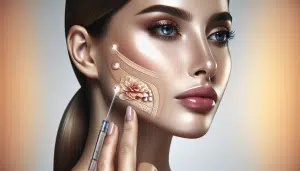Simple Habits That Transform Your Skin Fast
Charlotte Stone September 24, 2025
Learn how everyday skincare changes and mindful habits can revitalize your complexion and maintain radiance. This guide explores evidence-based routines and natural wellness approaches that make glowing skin achievable for anyone.
Understanding Skin Wellness Foundations
Skin wellness is more than just using products; it’s about daily self-care and intentional routines. The skin, as the largest organ, reflects habits and health. Clean eating, consistent hydration, and stress reduction all play essential roles in building a lasting glow. When you nourish your body, focus on sleep, and aim for overall wellness, your complexion often reveals the benefits. Many overlook how internal health—like what you eat and how you manage stress—impacts texture and radiance. Consistency is crucial. Small, positive changes develop into deeply rooted behaviors that support beautiful skin. Dermatology experts also emphasize gentle cleansing and attentive moisturization to strengthen the skin’s barrier and keep it resilient. Routine is not about perfection. It is a pathway to ongoing improvement. An informed approach helps you understand what truly matters for wellness, regardless of trends.
Nutrition and hydration are two cornerstones of optimal skin health. Antioxidant-rich vegetables, whole grains, and healthy fats all contribute to a luminous appearance through support at the cellular level. Incorporating colorful, plant-based foods can feed your complexion from within. Healthy fats like those found in avocados, nuts, and olive oil are known to support elasticity and help retain moisture. On the hydration front, keeping water intake steady can improve elasticity—preventing dryness and dullness commonly linked to dehydration. Even sleep quality matters; during deep rest, the body repairs and regenerates skin cells, contributing to a smoother, fresher look by morning. Multiple studies highlight the synergistic effect between lifestyle adjustments, diet, and visible skin improvements, emphasizing a holistic approach (Source: https://www.nih.gov/health-information/skin-health).
External care routines are just as important. Choosing gentle cleansers and alcohol-free toners lets the skin retain vital moisture. Over-cleansing can compromise the skin barrier, which may lead to increased sensitivity and redness. Individual needs vary, but the most effective skincare regimens use sun protection, targeted serums, and non-comedogenic moisturizers. Sunscreen is non-negotiable; ultraviolet exposure is the leading cause of premature lines, dark spots, and sagging, making daily sunblock a foundational step for longevity and youthfulness. Habit formation—gradually incorporating new, evidence-based habits—can empower long-term skin transformation. With the basics in place, layers such as serums and facial massages can be tailored, offering a personal dimension to healthy indulgence and ongoing skin renewal.
Key Daily Habits That Lead to Radiant Skin
Daily practices form the secret to a radiant complexion. Morning and evening routines tailored to your skin type allow for gentle cleansing, balanced moisturizing, and targeted treatments aligned with your evolving needs. For example, starting the day with a splash of lukewarm water, followed by a hydrating serum and a broad-spectrum sunscreen, supports lasting vibrance and protection. Even those new to skincare can build routines by focusing on cleansing, hydration, and SPF. Habitual use of sunscreen is particularly powerful, as it not only preserves youthful tone but also reduces the cumulative impact of environmental aggressors (Source: https://www.aad.org/public/everyday-care/skin-care-basics/care).
Long-term skin wellness often goes beyond what you apply topically. Mindful choices before bed—such as thorough makeup removal and light moisturization—support natural overnight repair. Incorporating gentle exfoliation, once or twice weekly, encourages brightening and reduces buildup without irritating the skin. Consistent application is key because sporadic care seldom yields visible results. The habit of changing pillowcases and cleaning makeup brushes helps prevent congestion and inflammation. Many also find benefit in keeping phone screens clean to avoid unnecessary contact with facial skin. Thoughtful details like these add up and set the foundation for radiance that continues to improve over time.
Stress management and restorative sleep are transformative for skin appearance. Elevated stress levels may worsen inflammation or trigger breakouts and dullness by disrupting hormone balance. Finding small ways to unwind—such as short meditations, walks in nature, or a bedtime skincare ritual—can drastically influence the skin’s resilience and vibrance. Combining day-to-day routines with quality sleep and stress-reduction leads to a more vibrant, even complexion. If sleeping schedules are inconsistent, consider setting a gentle wind-down routine with low lighting and calming scents. The body’s natural nightly healing processes thrive in restful settings, making radiant skin a reflection of peaceful habits, not just products.
Choosing Products for Your Individual Skin Type
Every skin type—be it dry, oily, combination, or sensitive—benefits from targeted care tailored to unique needs. The foundation of a great routine is product selection based on ingredient transparency and suitability. People with dry skin often prefer richer, ceramide-packed moisturizers, while those with oilier skin types lean toward gel-based hydrators and non-clogging formulas. Sensitivities can complicate matters, making fragrance-free, minimalist products especially beneficial. Cleansing choices—like oil cleansers for dry types and foaming formulas for oily skin—are significant. Patch testing new items is always smart. It can prevent unwanted reactions and help identify optimal matches through slow, intentional exploration. Dermatologists advise simple approaches and gradual changes rather than chasing trends or using too many active ingredients at once.
Understanding ingredient labels is crucial when choosing new products. Modern skincare often spotlights antioxidants, peptides, ceramides, and humectants like hyaluronic acid. Each ingredient contributes in its own way—antioxidants help shield from pollution, peptides support firmness, and ceramides strengthen the barrier. For those concerned about uneven tone or signs of aging, ingredients such as niacinamide and retinol, used appropriately, can make noticeable differences. It’s key to avoid unnecessary overlap or overuse, especially with actives. Consulting reputable dermatology resources or professionals for personalized tips is always suggested (Source: https://www.fda.gov/cosmetics/cosmetic-ingredients).
Allergic reactions and sensitivities sometimes occur, even with the most reputable formulas. Gradual adoption and careful observation reduce risks. If redness, stinging, or breakouts appear, stop use and revisit ingredient lists. Individualized routines mean it may take time to discover the right mix. However, investment in patience and mindful experimentation leads to enduring, satisfying results. Staying consistent with gentle, effective core products allows time for gradual improvement, supporting stronger, healthier skin across all ages and backgrounds.
The Powerful Role of Nutrition in Skin Health
Nutrition is a driving force behind healthy, radiant skin. While topical products target specific concerns, the food you eat provides foundational support that shapes your complexion’s resilience. Diets rich in leafy greens, colorful fruits, and healthy fats often correlate with a brighter, more even tone. Omega-3 fatty acids, found in chia seeds, walnuts, and fatty fish, are known to reduce inflammation and foster a supple, hydrated texture. Additionally, limiting processed foods and sugars may reduce the risk of breakouts and promote long-term clarity. The interplay of vitamins A, C, and E will also provide antioxidant protection against free radical damage, enhancing your natural glow through regular consumption (Source: https://www.hsph.harvard.edu/nutritionsource/vitamins/vitamin-e/).
Staying hydrated is essential for maintaining elasticity and minimizing the appearance of fine lines. Water acts as the body’s internal moisturizer, flushing out toxins that can lead to dullness or blemishes. For some, herbal teas and water-rich fruits add variety and extra nutrients. Simple hydration habits—such as carrying a reusable bottle—can have outsized impact. Skin thrives in an environment where nutrients and moisture work together, fueling repair and regeneration. This synergy explains why a balanced plate, packed with whole ingredients, is regularly linked to lasting improvements in skin condition. Even popular superfoods like berries and spinach get their reputation from antioxidant benefits proven in research.
Beyond individual foods, the overall pattern of eating influences how skin performs as a barrier. Some find success with Mediterranean-style diets, which emphasize healthy fats, greens, and moderate protein. Others benefit from plant-based meals that bring plenty of fiber and micronutrients. While there’s no universal solution, focusing on variety and freshness usually delivers results over restrictive plans. Lifestyle factors, like limiting alcohol and avoiding smoking, contribute to maintaining a healthy glow and reduce the risk of premature aging. A mindful approach to eating—enjoying meals without rushing, savoring flavors—can further support stress management while benefiting skin resilience.
Developing Mindful Beauty Routines for the Long Term
Long-term skin health is nourished by routines that blend effectiveness, simplicity, and enjoyment. Daily discipline builds momentum, but so does mindful flexibility. Instead of strict regimens, many find success by adapting based on changing seasons, stressors, or goals. Seasonal shifts, for example, may prompt switching to richer moisturizers in colder months or lighter gels during heat waves. Setting realistic intentions—such as cleansing nightly or applying sunscreen daily—anchors habits as reliable cornerstones. Tracking progress through personal journals or photos can motivate sustained engagement, making skincare both measurable and rewarding. Regular self-care, far from being indulgent, becomes a powerful act of self-respect and wellbeing.
Integrating wellness practices like facial massages, short meditations, or positive affirmations can elevate standard routines into truly restorative rituals. Taking time to gently massage the face while applying serum improves circulation and can lift mood. Mindfulness encourages attention to sensation and gratitude for the process, anchoring you in the moment. Many people discover that beauty routines are a form of self-care that serves emotional as well as physical health. Stress reduction benefits the complexion indirectly, providing resilience in the face of environmental and hormonal fluctuations. As self-care becomes habitual, the feeling of radiance can match what is seen in the mirror.
Celebrating small wins along the journey is important. Minor improvements—like softer texture, fewer breakouts, or a more even tone—should be recognized. Most experts caution that progress takes weeks of steady effort, not overnight fixes. Setting gentle, realistic goals prevents frustration and supports long-lasting change. Remember, healthy skin is not about perfection. It is about feeling comfortable and confident in your own skin. Ongoing education, curiosity, and patience make all the difference when building habits that continue to pay off over a lifetime. Your glow reflects an ongoing commitment to yourself, not just surface-level fixes.
Tips for Avoiding Common Skincare Mistakes
The journey toward radiant skin may be derailed by well-meaning but harmful mistakes. Over-exfoliation, for example, can strip natural oils and disrupt the moisture barrier, leading to irritation and increased sensitivity. Less is often more—using too many strong products at once doesn’t accelerate results. Sometimes, mixing active ingredients (like retinol and acids) can provoke redness or flaking. Experts stress building routines slowly, letting skin adjust to each new step. Reading instruction labels and understanding ingredient lists minimizes risk. When in doubt, opting for gentle basics protects against many of the pitfalls associated with ambitious routines (Source: https://www.dermatology.ca/public-patients/skin/skin-health/general-skin-care/).
One of the most common missteps is skipping daily sun protection. UV rays can harm skin year-round, penetrating clouds and glass. Even brief exposures accumulate over time, contributing to fine lines, uneven tone, and increased cancer risk. Developing the consistent habit of applying sunscreen—rain or shine—helps prevent much of this damage. Another miscalculation is using products not suited for an individual’s specific type. What works for a friend may not suit your unique combination of needs, sensitivities, and goals. Patch testing can avert problems by revealing incompatibilities early, giving time for adjustments before widespread use.
Ignoring the influence of lifestyle can undermine even the most diligent skincare regimens. Sleep deprivation, ongoing stress, and poor diet are reflected almost immediately in dull tone, breakouts, or puffiness. Experts recommend viewing healthy skin as the outcome of daily living, not just the contents of bathroom shelves. External treatments work best when combined with hydration, nourishment, and emotional self-care. Understanding these nuances supports realistic expectations while maximizing your potential for glowing, resilient skin.
References
1. National Institutes of Health. (n.d.). Skin Health. Retrieved from https://www.nih.gov/health-information/skin-health
2. American Academy of Dermatology. (n.d.). Skin Care Basics. Retrieved from https://www.aad.org/public/everyday-care/skin-care-basics/care
3. U.S. Food and Drug Administration. (n.d.). Cosmetic Ingredients. Retrieved from https://www.fda.gov/cosmetics/cosmetic-ingredients
4. Harvard T.H. Chan School of Public Health. (n.d.). Vitamin E. Retrieved from https://www.hsph.harvard.edu/nutritionsource/vitamins/vitamin-e/
5. Dermatology.ca. (n.d.). General Skin Care. Retrieved from https://www.dermatology.ca/public-patients/skin/skin-health/general-skin-care/
6. Mayo Clinic. (n.d.). Skin care: 5 tips for healthy skin. Retrieved from https://www.mayoclinic.org/healthy-lifestyle/adult-health/in-depth/skin-care/art-20048237







